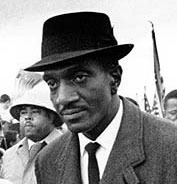Frederick D. Reese
Dublin Core
Title
Subject
Description
By signing a letter inviting Martin Luther King Jr. to lead the march from Selma to Montgomery, Frederick D. Reese transformed himself from a local to a national leader. A modest and soft-spoken man, Reese was a Baptist minister and president of the Dallas County National Voters League at the time of the march (“Activist Still Active”). During the interview, he focused on his role as community organizer rather than simply as the one responsible for bringing Dr. King to Selma. Since the white school board controlled the black teachers’ jobs, Reese was well aware of the risk that each and every teacher and parent in the movement took in order to participate in the marches for freedom. Reese’s ability to organize teachers to march to the Selma courthouse and demand the right to vote was an important step in the transformation of such a segregated city. Reese recalls “at the end of that one minute [Sheriff Jim Clark] and his posse took their billy clubs and knocked us down the steps. We regrouped and went back a second time. Again he gave us another minute and then he knocked us down the steps again” (Hampton 218-219).
In some ways, Reese was at odds with the more grassroots SNCC organization given that he chose King, a national leader from outside Selma, to lead the march. In contrast, SNCC focused their efforts on training community members as activists to organize their communities toward action on a local level. Reese realized that nonviolent protest was the linchpin of the movement; his efforts focused on “those who really wanted to take up whatever arms they had and retaliate with violence” (229). However, Reese believed that the Selma march could not be planned as only a local action: he extended an invitation to activists all over the country to come to Selma with the intention to join the local community. While he did not explicitly disapprove of young children in the march, he was well aware of the physical and psychological coercion of Black adults by law enforcement. Still, the presence of children in the movement was the result of an array of members of a community both local and national committing to march. Reese knew the value of an appeal to a wider, more Northern audience to garner media attention and to place national scrutiny on one of segregation’s strongholds in the South.
According to Leigh Raiford, the “grammar of intersection between movement and medium” bridged the gap between local advocacy and national attention. Especially in the case of Henry Hampton, the project of Black activists documenting a Black movement from their point of view gave them autonomy over their own narrative—sometimes for the first time—to counter the coverage by mainstream media (127). In his interview, Reese emphasized the teachers and beauticians, among others, who came together by profession in order to march to the courthouse and later march on the Edmund Pettus Bridge (Hampton 219). The photographers were no exception: “photographs served as both performances of liberatory possibility and as documents of democracy in action” (Raiford 127). The onset of this photography instilled in the Selma march participants a pride in the nonviolent goals of their movement. Even though the first instinct of the mainstream media may have been to gawk at the spectacle of violence against Black people, “in this movement, camera, photographer, and movement worked to produce affective and effective documents for social change.” While no one entity can fully control the dissemination of the image once it has been created, it is the very creation in and of itself and the usage of a medium on the cusp of innovation that gave rise to a Black movement on both a local and a national scale.
Creator
Source
Publisher
Citation
Catalog Search
Search for related records in these catalogs:
